
Material - Glass Block
Glass blocks are often associated with Streamline Moderne designs, probably because they first appeared as a viable building material in America in 1933 at the beginning of the Streamline Moderne period. But that's starting in the middle of the story, so let's go back to the beginning.
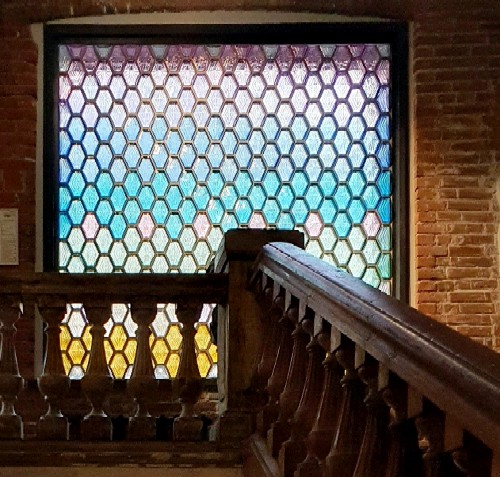
Brique de Verre by Gustave
Falconnier, Moscow Museum of Architecture, Archi.ru
The first known true glass 'brick' ('brique de verre') was created by French architect Gustave Falconnier in 1886. These bricks were blown in a mold like glass bottles, leaving an opening at the top which was sealed with a molten glass plug while it was still hot. As the block cooled, the air inside cooled, creating a partial vacuum. They were designed to be used like any other brick with mortar in between them. Falconnier filed patents for various shapes and colors of his glass bricks in the 1880s (see the image at right) and revealed them to the public at the 1893 Chicago World's Fair and 1900 Paris Exposition. Being made of blown glass, some blocks to fog up inside over time which required them to be replaced. They also lacked the strength required to support large applications. Nevertheless, Swiss-French architect Charles-Édouard Jeanneret (aka le Corbusier), a noted modernist, used them for small windows found in his 1916 Villa Schwob.
Most of Falconnier's bricks had a natural light aqua tint caused by iron in the sand used to make them, but he created other colors at extra cost including clear, amber, green, blue and milk glass opal. "A red brick was made by casing a clear brick in a thin layer of expensive, gold-ruby glass; they were more than twice the cost of other colors. The patent talks of coloring 'either in the mass or by coating or covering them inside or outside in full or in part with layers of metal or paint'". ("Gustave Falconnier's Blown Glass Bricks", Glassian website, gathered 5-5-24)
In 1896, the Radiating Light Company was started by James Pennycuick to sell his patented glass blocks which added horizontal prisms to the back side of square glass tiles. The next year, the name was changed to the Luxfer Prism Company. The tiles came in several colors with clear being the standard. Purple tiles were created with the addition of manganese, green and yellow were mentioned as color options the company. There are also examples of teal and yellow as seen below. Luxfer is probably best known today with working with Frank Lloyd Wright who created 45 tile designs which were patented.
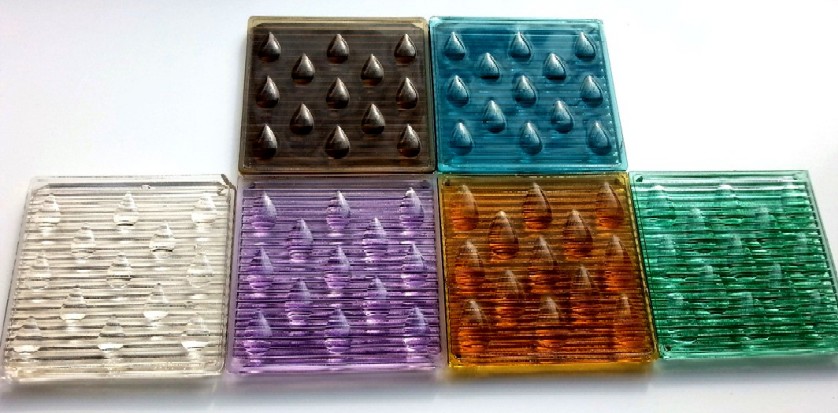
Colored Glass Bricks, Luxfer Glass Prism Tile Colors, Luxfer Glass Prism Collector on Weebly.
Around 1901, glass blocks began to be manufactured in Germany with an eye towards using them for fire prevention. In 1903, Siemens Company created stronger glass blocks, introducing a rectangular style which became popular in Europe. "These blocks were thicker and were more fireproof, a main concern of the time, albeit a bit more expensive than the Falconnier blocks." (Elizabeth Fagen, "Building Walls of Light: The Development of Glass Block and Its Influence on American Architecture in the 1930s", Master's Thesis for Historic Preservation, Columbia University, 2015, p. 15)
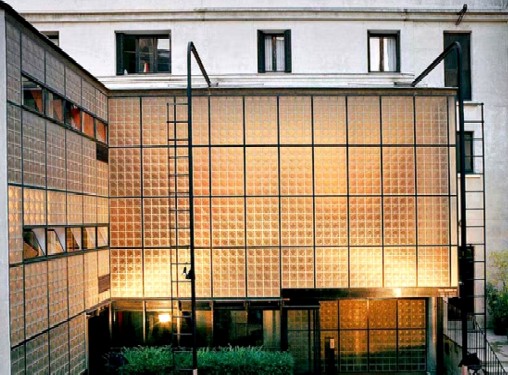
Glass Block, House of Glass, Pierre Chareau and Bernard Bijvoet, Paris
In 1928, the French Saint Gobain Company introduced their Nevada glass brick, which was a square block of solid glass designed to be set into a steel frame. They had a concave circular interior to reduce their weight. Nevada bricks were used in the exterior facade of the Paris 'House of Glass' designed by architects Pierre Chareau, and Bernard Bijvoet which was completed in 1931. (See the image at right.)
Although the blocks in the Maison de Verre were solid, not hollow glass blocks, this building was an extremely important precedent structure to the history of hollow glass blocks. The Maison de Verre helped to spark the popularity of glass blocks, as it was one of the first buildings to use this new material for most of its façade. The dramatic appearance of the building, especially at night, introduced the idea that glass could replace the traditional masonry wall, and this idea would be incorporated into American architecture shortly after the completion of the Maison de Verre. (Fagen, p. 22)
The first American manufacturer of hollow glass blocks may have been the Structural Glass Company in New York started by German Fredrick L. Keppler. Some suggest the company began manufacturing glass blocks in 1929,
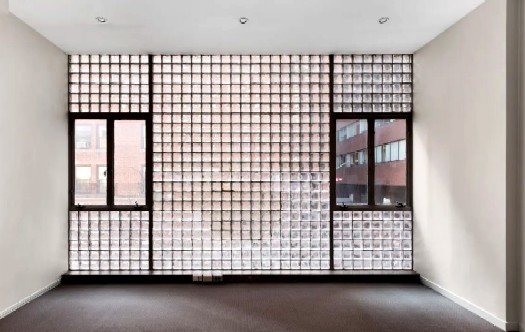
Macbeth-Evans Glass Blocks, William Lescaze Interior Block Wall, 1933-4, 6 Sqft
although Structural Glass doesn't appear in a building manufacturer's catalogue until 1931. In 1934, a Chicago representative of the company indicated that they were sales agents for the Siemens glass blocks, so they may have just been importing the Siemen's product, never actually never actually having manufactured them. (Fagen, p. 35-6) Another possible early manufacturer of glass blocks was the Macbeth-Evans Glass Company in Pennsylvania, although it is not known when they began producing them making it difficult to state that they were the first American manufacturer. The William Lescaze house in Manhattan was built in 1933-4 using Macbeth-Evans glass blocks, so we know they had started production by that time. (See the image at right.)
The most notable early residential use of glass block is found at the William Lescaze House & Office at 211 East 48th Street in Manhattan. ...One of the first Modern style residences in the city, the building had a great impact on the popularity of glass block. The Lescaze House was a dramatic departure from the nineteenth century brownstones that surrounded it. The facade, with its simple, flat forms, showed that glass block was part of a new movement of architecture - away from the Art Deco movement into a new style that emphasized angular lines, planar surfaces, functionalism, and little to no ornamentation." (Fagen, p. 48)
Two New York skyscrapers were completed in 1930 which employed glass blocks in their construction: the Barbizon Hotel, which used German glass blocks and the New York Towne House, which used Dutch glass blocks. The Towne House construction was completed in 1930 using colorful purple-red glass blocks.
The popularity of glass blocks in projects like these inspired the Owens-Illinois Glass Company to begin test manufacturing them in 1932.
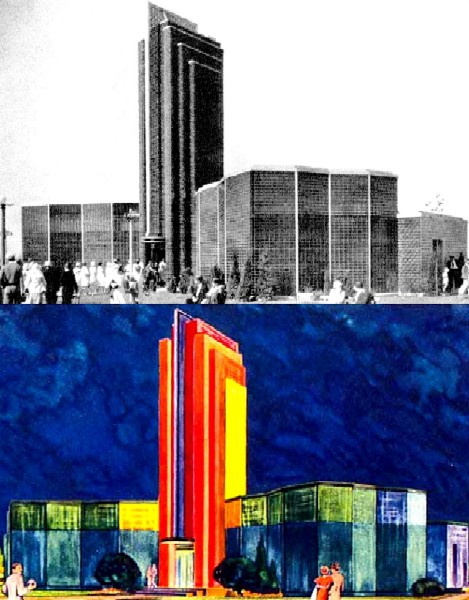
Owens-Illinois Glass Block Building, Photo (Top) and Color Artists' Rendering From
a Postcard (Bottom), Century of Progress Exhibition, Chicago, 1934
This makes them the first manufacturer of them in American which can be verified. To test their product, they built a house entirely from glass block. Owens then built a glass block building at the seminal Streamline Moderne Century of Progress Exhibition (1933-34) in Chicago which introduced their glass blocks to the public. Owens' blocks were molded on five sides with the sixth side being hermetically sealed using another piece of flat glass. The glass blocks were painted so that when the building was lit inside, the colors glowed. "Color was applied to five sides of the block, leaving the exterior face bare. According to reports, 'any color in the entire gamut of the spectrum is applied to these blocks, giving an immense range to their decorative possibilities.'" (Fagen, p. 44) It is not clear whether Owens painted the inside or outside of the blocks. Although there were no color photos of the building, there is an artist's rendering from a postcard which shows the colors.
The Glass Block Building at the Chicago Century of Progress Exhibition was arguably one of the most important early glass block buildings which showcased the dynamic relationship between glass block and lighting. The multicolored appearance of the block helped to advertise Owens-Illinois’ product as a material which offered new possibilities in form (since the blocks could be used to build a building in any shape or plan), and in aesthetics (since the level of illumination could be changed, and there was also an ability to add colors). Although the Glass Block Building was only a temporary structure, it helped to set a precedent for the future of glass block. (Fagen, p. 43-4)
Although Owens-Illinois used Insulux Glass Blocks at the Exhibition, they were not made available to the public until 1935. They planned to produce them as 'translucent masonry' in a variety of colors in the way that they had done for the Century of Progress building. Planned colors included flint, light green, emerald green, amber, dark blue and black. (Fagen, p. 54) However, the 1936 catalogue for the product only mentions that the lighting can be changed to cause the Insulux glass blocks to change color so they don't appear to have done this. (Owens-Illinois Company, "Owens-Illinois Insulux glass blocks", 1936, p. 14) Still, Owens' building led to an awareness among architects of the possibilties of glass block.
The exhibit at the Chicago World's Fair created a boom in its use. "Glass block rose in popularity in a short period of time, and the height of its use was from around 1937 to the early 1940s. In this short period, glass block was used for almost every building type." (Fagen, p. 1) Fagen also points out that the ability to light glass blocks from the inside was one of the design's most significant contributions to architecture. Although colored glass blocks were not quite as popular as the regular blocks, the use of light behinds them would have added to their dramatic effect. Glass blocks are still available in a variety of colors today, colored using two different methods. The first starts with a colored glass and the second injects a colored dye or transparent paint into the hollow middle of the uncolored block which coats the inside.
References Not Mentioned Above:
"Glass Block building built for World's Fair", National Glass Budget, April 15, 1933, vol. 48, no. 50
Dr. Neil Gale, "Glass Blocks: a Chicago Invention for the 1893 World's Columbian Exposition", Digital Research Library of Illinois History website, gathered 5-5-24
Guglielmo Marttioli, "Crazy Tops: Barbizon Plaza Hotel", NY Curbism website, gathered 5-5-24
"Glass brick", Wikipedia.org, gathered 11-17-24
"Luxfer Prims", Frank Lloyd Wright Trust website, gathered 11-17-24 - https://flwright.org/explore/luxfer-prisms
"Brilly Inside Injected Colours", Seves Glass Block website, gathered 11-17-24
"New Colour Collection", Seves Glass Block website, gathered 11-17-24
Original Facebook Group Post on Glass Blocks
Original Facebook Group Post on Colored Glass Blocks
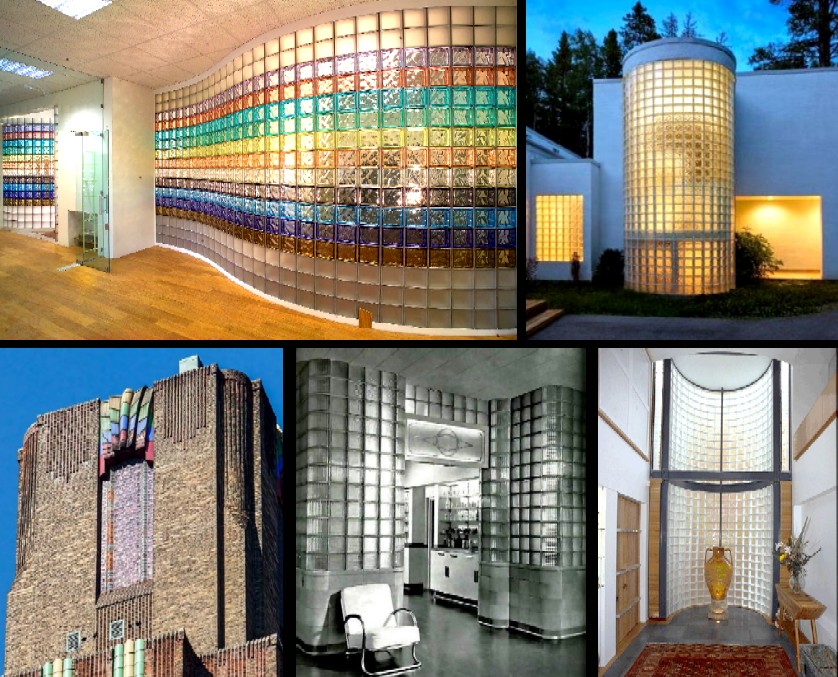 Glass Block Examples, From Top Left - Pegasus Colored Blocks, Modern, Sieves Glass Blocks Inc; Bragg Creek, Calgary House Lighted Inside, John Hallett Architect; Towne House with Purple Dutch Glass Block, New York, 1930; Vestibule, Owens-Illinois Pacific Coast Company, Kraftile Company, 1938; Vestibule, Curved Wall of Glass Blocks, Australia, Blokup
Glass Block Examples, From Top Left - Pegasus Colored Blocks, Modern, Sieves Glass Blocks Inc; Bragg Creek, Calgary House Lighted Inside, John Hallett Architect; Towne House with Purple Dutch Glass Block, New York, 1930; Vestibule, Owens-Illinois Pacific Coast Company, Kraftile Company, 1938; Vestibule, Curved Wall of Glass Blocks, Australia, Blokup